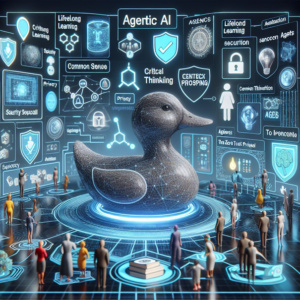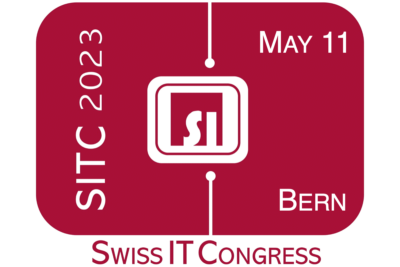When Tim Cook, CEO of Apple, claimed last year that a college degree would not be necessary to do well in the IT industry, he earned much criticism from the side of academics. However, reading his statement given at the Whitehouse to its full extent reveals another remark that should have created more uproar. There, he also noted that there is a “mismatch between the skills that are coming out of colleges and what the skills are that we believe we need in the future, and many other businesses do”, of which coding is a key part, although not the only one. Obviously, in the era of digitalization, colleges and universities do not seem to meet the demand of businesses and the public sector in terms of IT skills.
So, what are these skills that businesses and the public sector need for digitalization? And do we offer the right education at our Swiss universities, schools and high schools?
For answering these questions, we need to consider how digitalization is today accomplished. In the academic literature it is commonly accepted that any endeavor in digitalization first requires a certain level of maturity in terms of basic IT infrastructure and IT skills. Without knowing how to operate the basic functions of computers, smartphones, or tablets, to conduct basic tasks in an operating system or how to securely access internet resources, any digitalization attempt is doomed to fail. Although we often assume these skills to be present, experience from practice shows that many users of IT systems still have difficulties in understanding how to interact with a file system, how to ensure the secure transmission of information on the internet or how to create routine backups. Although we may claim that these functionalities should be taken care of by the providers of our operating systems and software applications or should be provided to us in a more intuitive way – and we have any right to do so – today, these skills are fundamental to enter the digital world and navigate through it safely.
After that we can start considering the skills required for digitalization. So, what is digitalization actually? Is it just the use of new technology? And what does it mean if we change an activity in a traditional process to a digital form? Can we for example just replace the activity “Send invoice or tax form by mail” with “Send invoice or tax form by e-mail” without further ado?
The answers to these questions will vary of course depending on the size of a business, public sector or community. While a large business and governments will need to involve several decision makers for conducting such changes, a one-person company will require less effort. However, several follow-up questions will occur in both cases. For example, when sending an invoice or tax from by e-mail, how is the correct e-mail address ensured and how are customer or citizens data stored in an efficient way? What happens in case of a failure of the e-mail server or the server storing the customer or citizen data? Will anyone notice these failures and how will they react? And can the business or public administration continue its existence if the invoices or tax forms cannot be sent by e-mail over a longer time period or if the customer respectively citizen data are lost? Although these questions may seem simple at first, they require quite some effort and skills for answering them properly. What is required is a fundamental understanding of how information systems work, which technologies offer which capabilities and what are their limitations, and how digital transformation works. The bigger an organization respectively institution becomes, and the more transactions are based on IT systems, the more complex the answers to these questions get. And even though many tasks related to IT and the potential risks involved in them may be mitigated by an external service provider who issues according guarantees for ensuring a certain level of service, the negotiation of such agreements requires a good understanding of the underlying technological environment.
Yet, these skills and tasks are just the day-to-day IT business and government in any modern organization and institutions. In terms of digitalization, these are hygiene factors (i.e. something that does not make one particularly satisfied but that would lead to considerable distress if not present). What we are really interested in are capabilities that permit businesses and public administrations to create innovative, new products and services based on information technology. This means not to depend on third parties for designing new IT-based solutions, for creating new product-service offerings that leverage digital technologies in new ways and for implementing first prototypes to evaluate the feasibility of such endeavors. How can that be achieved? And what skills does one need to possess for this purpose?
On the one hand this necessitates a high familiarity with an organization’s or government’s environment, a thorough understanding of how business is conducted and processes are enforced in this environment and what the needs for products and solutions are. On the other hand, the above illustrated basic understanding of technologies is not enough here. Successful actors need to be equipped with skills to create according IT solutions themselves rather than relying on others for driving innovation. This aspect of digital self-sovereignty is currently highly debated as many IT innovations are made outside of Europe.
This concerns not only the knowledge on how to program a software but also to design and engineer a corresponding, scalable, robust and secure software architecture that is aligned with the future product or service offering. When aiming for long-time, sustainable solutions, also the capability to familiarize oneself with the most recent technologies is essential, to make use of them and understand their inner working. This is done by abstracting from concrete implementations for identifying the core properties that will be relevant in the future. All this goes far beyond the ‘coding skills’ that Tim Cook had mentioned.
As an example, consider a manufacturing company producing home appliances such as dishwashers, ovens or washing machines. Imagine now that this company has the idea to connect its tools to the internet for monitoring the usage of the tools and offering a preventive maintenance service that is able to automatically detect any required repairs before the machine breaks down. For realizing such a service, at first the IT infrastructure must be designed for connecting tools to the internet (e.g., using IoT and DLT). This not only involves hardware as well as software components and an according IT architecture but also the design of according processes and organizational and institutional responsibilities. Today, this is typically achieved through cloud-based architectures, which may either be run on-premise or sourced from an external service provider. It must be decided how the tools are onboarded onto the service, how the authentication takes place, which and how much data is transferred, where the data is stored, how the maintenance algorithm works, how the customers are notified, how support is provided in case of failures and how responsibilities are assigned in the organization and institution. This all needs to be aligned with the actions of the customers in this scenario (e.g. for activating the service on the device and for configuring it). Further, the business and government aspects come into play as well, e.g. in terms of additional costs and the price that customers are willing to pay. This in turn affects the design of the technical architecture and processes of the service, e.g. whether a payment function is needed, whether a real-time monitoring is necessary or whether an edge computing solution is more adequate for saving bandwidth and improving response times. The designers of the solutions also need to be aware of the customers they want to address. What are their specific requirements? Will the new service fit well with their work routines? Which training will they need to undergo?
The answers to these questions demand both profound technical knowledge as well the understanding of the targeted customer segment and business/government environment. Whereas the experience in designing and engineering such solutions for productive environments can only be gained in practice, academic education can contribute the foundation for the entry into the industrial work life and ensure the long-term sustainability of the acquired knowledge.
The discipline of business informatics has evolved over the last more than fifty years with exactly this goal in mind. From the beginnings in data processing to the establishment of digital organizations and institutions, business informatics has always aimed for producing graduates who can design and implement IT solutions for business, governmental and societal requirements. Like the Maker culture where people create new physical tools equipped with electronic or IT interfaces using existing components, business informatics is an engineering-oriented discipline that reverts to a multitude of methods from computer science, business and economics. In addition, business informatics develops its own methods that specifically target the alignment of domain requirements with technical systems, e.g. in the form of visual enterprise modeling methods.
Business informatics thus takes a holistic perspective on the digital transformation of organizations and institutions. For accomplishing this, graduates in business informatics are equipped with technical skills in programming, design of algorithms and software architectures, databases, security and distributed systems. Specializations typically include today fields such as artificial and computational intelligence, big data infrastructures, robotics, human-computer interaction as well as soft computing. In addition, they receive profound training in business and public administration, operations management and logistics, accounting, finance, marketing, law and economics. For learning how to conduct the alignment of requirements and technical systems, they are further trained in requirements engineering and the conceptual modeling of information systems, including business processes, enterprise architectures and software systems. Towards the end of their studies, they have to demonstrate their skills in an information systems development project that includes the entire cycle from eliciting requirements for a given scenario, the implementation of an IT solution and the handover to the customer. On the level of PhD studies these skills are further complemented by the ability to develop long-term, sustainable solutions, abstract from concrete technologies and gain competencies for strategic thinking through structuring complex domains and adaptive systems.
The feedback on this type of education from Swiss businesses, regardless whether from organizations or institutions is very positive and obviously meets today’s demands. We believe that the discipline of business informatics can contribute to the digital self-sovereignty of Switzerland in making IT solutions for organizations, institutions and the society as a whole. From an academic perspective, the most important skill of graduates is however the ability to learn by oneself, constantly expand one’s capabilities and identify the value added by new technologies.
The newly formed Special Interest Group Business Informatics of the Swiss Informatics Society provides a forum for all colleagues engaged in business informatics research and education as well as all representatives from industry and public administration. The SIG plans to establish collaborations on the international scale, e.g. with the Special Interest Group Business Informatics of the German Informatics Society (GI FB-WI), the French network MIAGE (Méthodes Informatiques Appliquées à la Gestion des Entreprises) and the Austrian Computer Society (OCG). The language for all communications of the SIG is English to ease the exchange between all language regions of Switzerland.
We are looking forward to your participation in the SIG Business Informatics!
Authors: Hans-Georg Fill, Edy Portmann – University of Fribourg
_____
![]() Hans-Georg Fill is a full professor at the University of Fribourg and head of the Digitalization and Information Systems Group. Prior to his engagement at the University of Fribourg he held positions at the University of Bamberg, Germany and the University of Vienna, Austria. In addition, he was a visiting scholar at Stanford University, USA, the Ecole Nationale Supérieure des Mines at Saint-Etienne, France and the Karlsruhe Institute of Technology, Germany. He holds a PhD and a habilitation in business informatics from the University of Vienna.
Hans-Georg Fill is a full professor at the University of Fribourg and head of the Digitalization and Information Systems Group. Prior to his engagement at the University of Fribourg he held positions at the University of Bamberg, Germany and the University of Vienna, Austria. In addition, he was a visiting scholar at Stanford University, USA, the Ecole Nationale Supérieure des Mines at Saint-Etienne, France and the Karlsruhe Institute of Technology, Germany. He holds a PhD and a habilitation in business informatics from the University of Vienna.
 Edy Portmann is Swiss Post Professor of Informatics at the Human-IST Institute of the University of Fribourg. His transdisciplinary research focuses on cognitive computing and its application to cities. After an apprenticeship as an electrician, he studied information systems, business as well as economics and, later, got a doctorate in computer science. Among others, he worked for Swisscom, PwC and EY. In addition, he was also a researcher at the universities of Singapore, Berkeley and Bern.
Edy Portmann is Swiss Post Professor of Informatics at the Human-IST Institute of the University of Fribourg. His transdisciplinary research focuses on cognitive computing and its application to cities. After an apprenticeship as an electrician, he studied information systems, business as well as economics and, later, got a doctorate in computer science. Among others, he worked for Swisscom, PwC and EY. In addition, he was also a researcher at the universities of Singapore, Berkeley and Bern.









